The Top Advantages of Terracotta Cladding for Commercial Buildings
In today's commercial architecture, choosing exterior materials isn't just about aesthetics—it's about performance, longevity, and environmental responsibility. Terracotta cladding meets these needs exceptionally well, offering a rare combination of acoustic comfort, energy efficiency, design flexibility, and durability.
From executive offices to healthcare facilities and institutional campuses, terracotta cladding is increasingly recognized as a wise, future-ready choice for building envelopes.
In this article, we explore the core advantages of terracotta cladding and how Sound-Rite delivers custom solutions that support both architectural vision and acoustic performance.
What is Terracotta Cladding?
The terracotta cladding consists of kiln-fired clay panels used as part of a building's outer envelope, often within a ventilated façade or rain-screen system. These systems feature an air gap between the structure and cladding panels, allowing for improved moisture drainage, enhanced air circulation, and improved thermal performance.
Terracotta panels are modular, durable, and compatible with both traditional masonry designs and contemporary glass and metal aesthetics. Terracotta systems are engineered for seamless integration with modern façade assemblies, helping designers balance appearance with performance.
Key Advantages of Terracotta Cladding
Exceptional Thermal and Energy Efficiency
Terracotta cladding also plays a critical role in regulating building temperature. Within ventilated façade systems, it contributes to passive cooling by promoting airflow behind the panels—a chimney effect that reduces heat buildup in summer and enhances insulation during colder months.
This temperature regulation helps reduce HVAC loads, stabilize interior climates, and lower long-term energy consumption. For projects targeting green building certifications such as LEED, terracotta can support multiple energy performance credits.
Architects and facility managers seeking sustainable façade systems often incorporate terracotta for its ability to meet both design and energy benchmarks.
Aesthetics and Customization
One of terracotta's most compelling attributes is its ability to support a diverse range of architectural styles. Available in a wide range of finishes—from smooth and matte to textured and glazed—terracotta can be used to accentuate visual rhythm or add warm, natural tones to contemporary structures.
The material can be shaped into custom extrusions, curved panels, or configured in vertical and horizontal orientations. It pairs exceptionally well with curtain walls, glazing systems, and metal cladding, making it a versatile choice for integrated façade design.
Terracotta's adaptability enables it to serve as a central design feature or a subtle complement to more expressive elements.
Durability and Low Maintenance
Beyond its visual appeal, terracotta is built to last. Its dense ceramic composition makes it highly resistant to UV radiation, temperature fluctuations, air pollutants, and impact. Unlike painted or composite panels, terracotta retains its natural colour and finish over time without fading or delaminating.
This durability translates into lower maintenance costs. Terracotta cladding typically requires only periodic washing to remove surface dirt and does not need repainting or sealing. For high-traffic or urban applications, glazed finishes provide an added layer of protection against graffiti and pollutants.
In terms of safety, terracotta meets stringent fire resistance requirements and is often rated as non-combustible. These attributes make it suitable for facilities with elevated fire safety and compliance standards.
Sustainability and LEED Contribution
Terracotta's environmental benefits are significant. It is made from natural clay, often sourced locally, and manufactured in low-emission processes. Panels are inert and fully recyclable at the end of their lifecycle.
Due to its material composition and performance characteristics, terracotta contributes to green building certification programs, including LEED, WELL, and BREEAM. It can support points in categories related to material reuse, indoor environmental quality, energy performance, and regional sourcing.
How Terracotta Compares to Other Cladding Materials
When compared with fibre cement, metal, or high-pressure laminate (HPL) panels, terracotta consistently ranks higher across key performance categories.
In terms of thermal regulation, terracotta used within ventilated façades can significantly reduce HVAC dependency, whereas metal and HPL systems are less effective insulators.
While fibre cement and HPL may offer visual flexibility, they can degrade more quickly, especially in environments exposed to UV light. Metal panels may require more frequent maintenance to prevent corrosion and colour fading. Terracotta, by contrast, requires minimal upkeep and maintains its appearance for decades.
Moreover, terracotta's fire resistance, sustainability profile, and long service life provide long-term value that many alternative cladding materials cannot match.
Ideal Commercial Applications for Terracotta Cladding
Terracotta cladding is particularly well-suited for:
Corporate headquarters are where brand identity, energy performance, and prestige materials are often priorities.
Hospitals and healthcare centers are where acoustic comfort, cleanable surfaces, and fire safety are critical.
University and institutional buildings require a balance between aesthetic appeal, durability, and acoustic functionality.
Commercial retail developments, where high-impact façades and long-term weathering performance reduce lifecycle costs.
In each of these environments, terracotta supports both architectural intent and the functional demands of high-occupancy, high-performance buildings.
Why Choose Sound-Rite for Terracotta Cladding Solutions?
Sound-Rite provides comprehensive support for commercial façade systems that require both aesthetic impact and functional integrity. Our experience in acoustic integration sets us apart, ensuring that your exterior cladding performs just as well in regulating noise as it does in defining the building's visual character.
We offer consultative guidance from the design phase through to installation, including:
Customization of panel formats, colours, and finishes to meet project-specific design requirements
Integration of terracotta with other architectural elements and systems
Whether you're designing a civic building, an institutional campus, or a modern office development, our terracotta cladding systems are engineered to support both your architectural vision and operational needs.
Final Thoughts
Terracotta cladding is more than a visual element—it's a multi-functional solution that meets the technical, environmental, and design expectations of today's commercial architecture. Its superior sound attenuation, passive thermal performance, design flexibility, and long-term durability make it one of the most comprehensive choices available for building envelopes.
If you're seeking a façade material that aligns with modern architectural values and performance criteria, terracotta stands out as a solution with both aesthetic credibility and technical depth.
To learn more or begin specifying terracotta for your next project, reach out to the team at sound-rite. We're ready to help you develop a tailored, high-performance façade system that supports your commercial goals.


